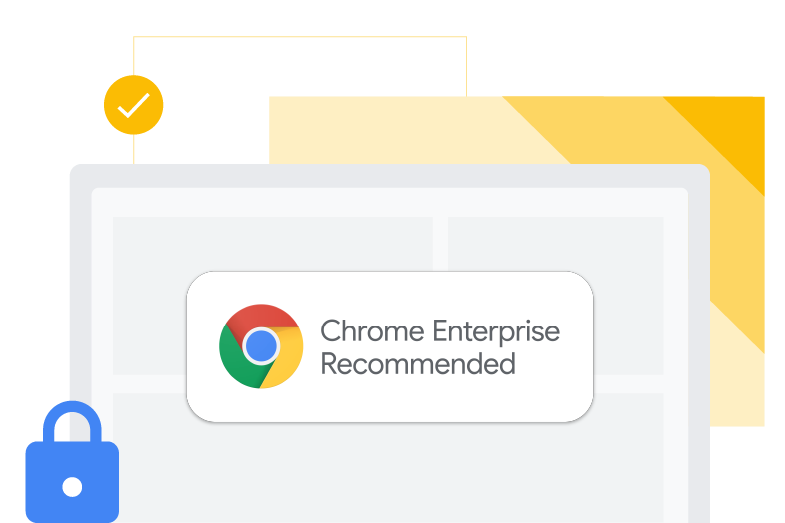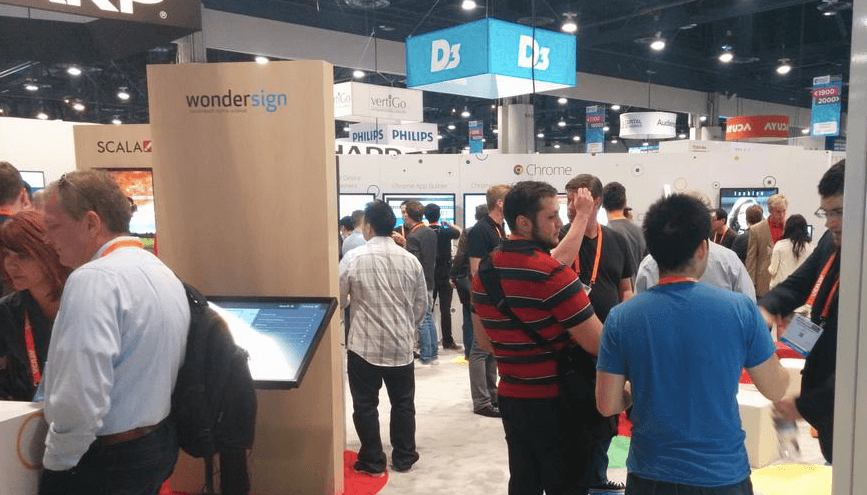
They’re Ba-a-a-ck!: Google Formally Re-Enters The Digital Signage Ecosystem
June 9, 2022 by Dave Haynes
Technology giant Google is formally finding its way back into the digital signage and kiosk business, though the company never really left.
There are many networks and many 1,000s of Chrome OS devices being used for digital signage and kiosks around the world. However, the company came into the signage market with a big splash and many named partners back in 2015 at Digital Signage Expo, as well as a VERY basic CMS.
While Chrome devices and the OS have stuck around and been used based on price, scalability and management features, Google itself has been very quiet. Back in 2015, I knew several Google people on the file, so to speak … but no one for the last three or four.
This is the big booth at DSE seven years ago …

Now the company has introduced a partner program for Chrome OS – a Chrome Enterprise Recommended solution track that has nine familiar companies involved at the head end: Arreya, Appspace, Comeen, MeldCX, Signagelive, StratosMedia, Trison, Upshow, and WAND Digital.
Google is also touting a $25 annual management license partners can can use to remotely manage, monitor, control, and secure their Chrome OS kiosk and signage devices, and new certified kiosk and signage devices for Chrome OS Flex.
The idea with Flex is that now Chrome OS can run on new or potentially repurposed Windows or Linux devices.
Says Google:
Alongside these new announcements, Chrome OS gives businesses an end-to-end integrated solution for kiosks and digital signage, whether they’re deploying menu boards, check-in kiosks, digital signs, or anything in between. With Chrome OS, you can:
- Reduce maintenance with a modern, reliable operating system: Automatic background updates, long-term support channels, and a stable operating system to keep devices running effectively without downtime.
- Ensure system security and data safety: Chrome OS blocks executable files from running, prevents apps and extensions from modifying the OS, and has built-in protection from malware with tamper-proof hardware. In fact, Chrome OS has never had a reported ransomware attack or virus.
- Monitor, control, and manage devices remotely: Remotely setup devices, deploy apps, reboot, disable, and monitor the health of all your devices through the cloud-based Google Admin console. And remotely monitor and control devices with Chrome Remote Desktop to ensure stability.
- Deploy validated kiosk & signage solutions: The new Chrome Enterprise Recommended solution track offers validated kiosk and signage applications that are guaranteed to work well with Chrome OS.
The main argument these days for Chrome are security, scalability and else of staying on top of and upgrading deployed devices (mainly media players in the context of digital signage):
- Comprehensive Security: Prevent data theft and attacks by remotely disabling or wiping devices that have been lost or stolen. Place devices in persistent enrollment, ensuring they are always enrolled in management, even if factory reset.
- Simple Remote Management: Simplify management of your organization’s device fleet with the easy-to-use, cloud-based Google Admin Console. Easily configure devices to boot directly into a kiosk or signage app, setup device policies, and access fleet insights.
- Scalable Device Monitoring and Controls: Monitor the health and operation status of all deployed Chrome OS devices and get useful device reports to ensure devices are running smoothly. Remotely take screenshots, control, and monitor devices to quickly resolve issues and guarantee stability through Chrome Remote Desktop.
- IT admin support: Contact Google for Chrome OS troubleshooting assistance with 24/7 support.
Chrome is heavily, heavily used out in the marketplace, but mainly in the education market – with many, many millions of Chromebooks in schools.
Google has had a Chrome Enterprise strategy for business for some time, but digital signage and kiosks have not been a focus. This time instead of just rounding up partners who’d like to give Chrome devices a try as a player for their CMS, this is a more thoughtful and thorough approach to companies getting involved and then validating their software.
That extends to technical evaluation of the software, and detailed sales and marketing alignment with Google. That part is key, as Google has a lot more clout knocking on enterprise than a 25-person CMS software shop.
It means the software firms have to run a Chrome Enterprise environment alongside the CMS, but the result is said by users to be a very stable solution.
The Flex part of it is particularly interesting. Chrome Flex comes out of Google’s Neverware acquisition – extending the reach of Chrome Enterprise beyond Chrome-specific devices to PCs and Macs.
It means existing devices, for example, can be repurposed for signage uses. I know one CMS firm that won a 4,000-plus license job based on being able to use existing company hardware that was going redundant as the end-user cut over to new multi-output PC devices running Flex.
The initial experience the industry had with Google was mixed, and when it was evident the tech giant was not all that engaged in the industry (it felt like a skunkworks effort), companies that expressed interest in Chrome backed off. It also didn’t help with things like rolling version releases of Chrome that weren’t, in the early days, coordinated with software firms and resulted in stuff abruptly not working.
This was a tightly coordinated announcement and several companies have issued PR talking about how they are involved:
“We are increasingly working with clients who wish to scale their digital estates globally and ensure that the digital experience is consistent whether you are in L.A, in London or in Seoul,” says Trison’s Peter Critchley. “Experience tells us that there is no better base platform for global digital roll-outs than Chrome OS. Having a simple, secure, manageable and eminently scalable platform upon which to build global digital estates has made this geographical reach and consistent customer experience a reality and we are delighted to see this strengthening of what is a major strategic partnership for us.”
“In developing Arreya in 2014, we knew we wanted our digital signage suite to be accessible by anyone, with no proprietary hardware,” says Jill Burgess, president of Arreya. “Google Chrome devices give clients nonproprietary hardware that anyone can afford, with the reliability of Google. Our partnership has allowed Arreya to grow and give our clients the freedom to remotely manage content and hardware.”
“We’re always looking for ways to add value to large-scale digital signage projects. Our verification by Google enables us to do just that by allowing us to offer a tried-and- tested, advanced and easy-to-manage enterprise solution with Chrome Enterprise Upgrade,” says Jason Cremins of Signagelive. “Streamlining the resource, and costs associated with large scale roll-outs, the integration of our platform with Chrome OS devices removes the barriers of complicated manual set-ups, and challenging user experiences. It offers, instead, a secure, proven, user-friendly solution that can deliver deeply immersive, and interactive digital signage experiences.”



Proud that our Signagelive is a launch partner for Chrome Enterprise Recommended.
Having supported ChromeOS since 2015 it is a proven robust and robust platform for unattended digital signage and kiosk applications.
Thanks for this info Dave. Its very encouraging to hear that they are recommitting—I’ve had my doubts through the years. I remember that DSE show well. It was quite the splash. We even had an interactive directory in that booth. Chrome box was our primary player when we first launched our airport specific CMS and it’s still a popular choice. Time to contact Google to get validated!
Won’t Google’s $25/year fee double CMS pricing for some of those partners?
Unfortunatly it looks this Chrome OS Flex will not be able to be installed in Chromeboxes that have reached the Auto Update Expiration. Leaving I guess a huge bunch of units out of work (including mines). Or does anyone knows if there is any way to reuse these?
And… as one giant get BACK in… another giant (Verizon) leaves… AGAIN… These “initiatives” will fail, just like their other tries for one reason… digital signage support is way too expensive (for them) after the sale.
Arreya has been with Google since they launched the Chromebox and thrilled they vetted us for the Chrome Enterprise Recommended Solution. Looking forward to the future of modern digital signage.